MP4702 Advanced Materials: Creep, Steel Transformation & Selection
VerifiedAdded on 2023/05/28
|11
|2223
|60
Homework Assignment
AI Summary
This assignment covers several key topics in materials science and engineering, including creep mechanisms (bulk diffusion, Coble creep), steel transformation diagrams (TTT diagrams, quenching, tempering, martensitic transformation), shape memory effect, hardness, and material selection for a connecting rod design. The student provides detailed explanations and calculations related to creep dependency on stress and grain size, methods to control creep, TTT diagram construction and interpretation, the impact of quenching and tempering on steel properties, the factors affecting hardenability, the principles behind shape memory effect, methods to improve hardness, and the design considerations for a connecting rod including constraints, objectives, free variables, mass equations, and material indices for fatigue and buckling. The assignment includes relevant diagrams and equations to support the explanations and calculations.
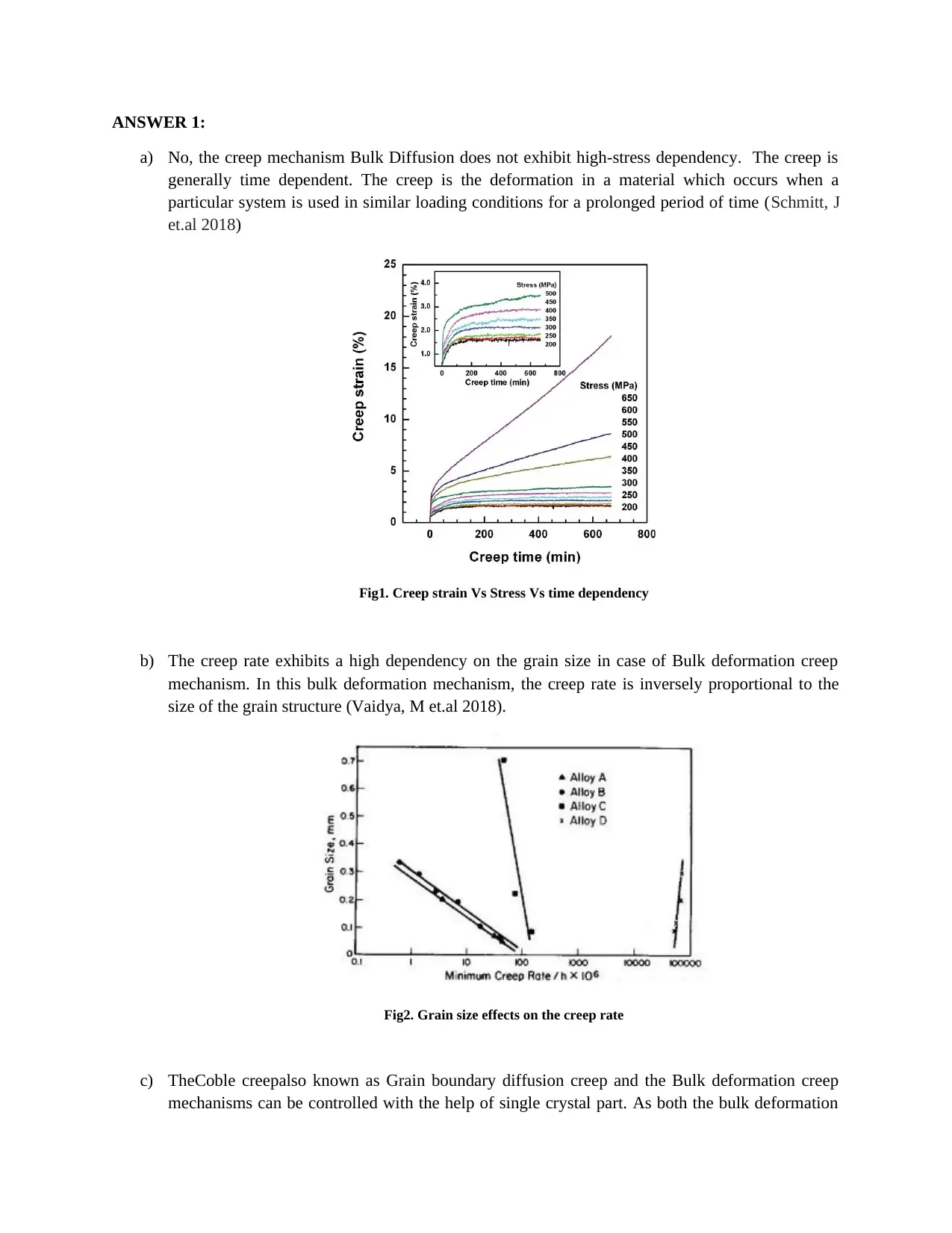
ANSWER 1:
a) No, the creep mechanism Bulk Diffusion does not exhibit high-stress dependency. The creep is
generally time dependent. The creep is the deformation in a material which occurs when a
particular system is used in similar loading conditions for a prolonged period of time (Schmitt, J
et.al 2018)
Fig1. Creep strain Vs Stress Vs time dependency
b) The creep rate exhibits a high dependency on the grain size in case of Bulk deformation creep
mechanism. In this bulk deformation mechanism, the creep rate is inversely proportional to the
size of the grain structure (Vaidya, M et.al 2018).
Fig2. Grain size effects on the creep rate
c) TheCoble creepalso known as Grain boundary diffusion creep and the Bulk deformation creep
mechanisms can be controlled with the help of single crystal part. As both the bulk deformation
a) No, the creep mechanism Bulk Diffusion does not exhibit high-stress dependency. The creep is
generally time dependent. The creep is the deformation in a material which occurs when a
particular system is used in similar loading conditions for a prolonged period of time (Schmitt, J
et.al 2018)
Fig1. Creep strain Vs Stress Vs time dependency
b) The creep rate exhibits a high dependency on the grain size in case of Bulk deformation creep
mechanism. In this bulk deformation mechanism, the creep rate is inversely proportional to the
size of the grain structure (Vaidya, M et.al 2018).
Fig2. Grain size effects on the creep rate
c) TheCoble creepalso known as Grain boundary diffusion creep and the Bulk deformation creep
mechanisms can be controlled with the help of single crystal part. As both the bulk deformation
Paraphrase This Document
Need a fresh take? Get an instant paraphrase of this document with our AI Paraphraser
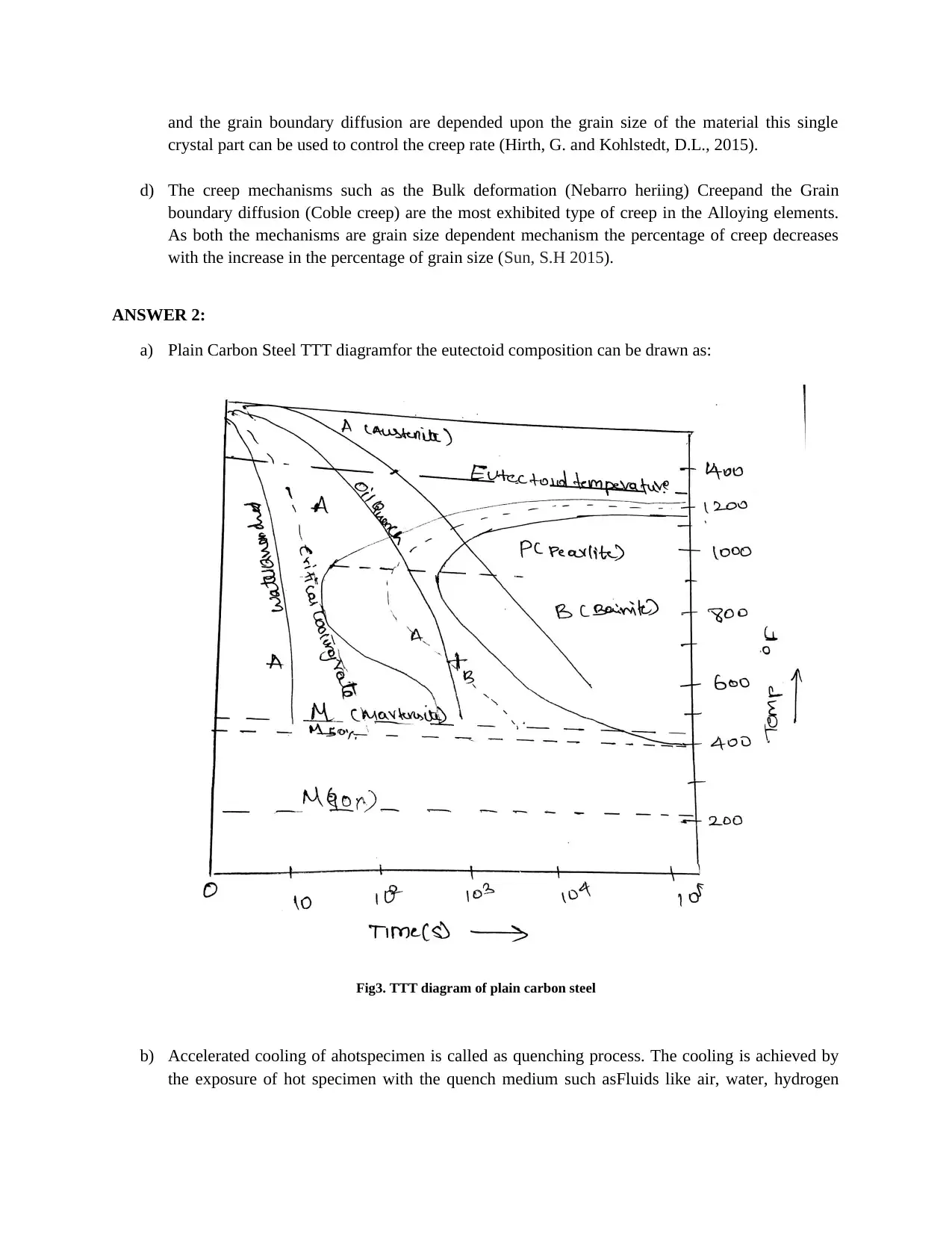
and the grain boundary diffusion are depended upon the grain size of the material this single
crystal part can be used to control the creep rate (Hirth, G. and Kohlstedt, D.L., 2015).
d) The creep mechanisms such as the Bulk deformation (Nebarro heriing) Creepand the Grain
boundary diffusion (Coble creep) are the most exhibited type of creep in the Alloying elements.
As both the mechanisms are grain size dependent mechanism the percentage of creep decreases
with the increase in the percentage of grain size (Sun, S.H 2015).
ANSWER 2:
a) Plain Carbon Steel TTT diagramfor the eutectoid composition can be drawn as:
Fig3. TTT diagram of plain carbon steel
b) Accelerated cooling of ahotspecimen is called as quenching process. The cooling is achieved by
the exposure of hot specimen with the quench medium such asFluids like air, water, hydrogen
crystal part can be used to control the creep rate (Hirth, G. and Kohlstedt, D.L., 2015).
d) The creep mechanisms such as the Bulk deformation (Nebarro heriing) Creepand the Grain
boundary diffusion (Coble creep) are the most exhibited type of creep in the Alloying elements.
As both the mechanisms are grain size dependent mechanism the percentage of creep decreases
with the increase in the percentage of grain size (Sun, S.H 2015).
ANSWER 2:
a) Plain Carbon Steel TTT diagramfor the eutectoid composition can be drawn as:
Fig3. TTT diagram of plain carbon steel
b) Accelerated cooling of ahotspecimen is called as quenching process. The cooling is achieved by
the exposure of hot specimen with the quench medium such asFluids like air, water, hydrogen
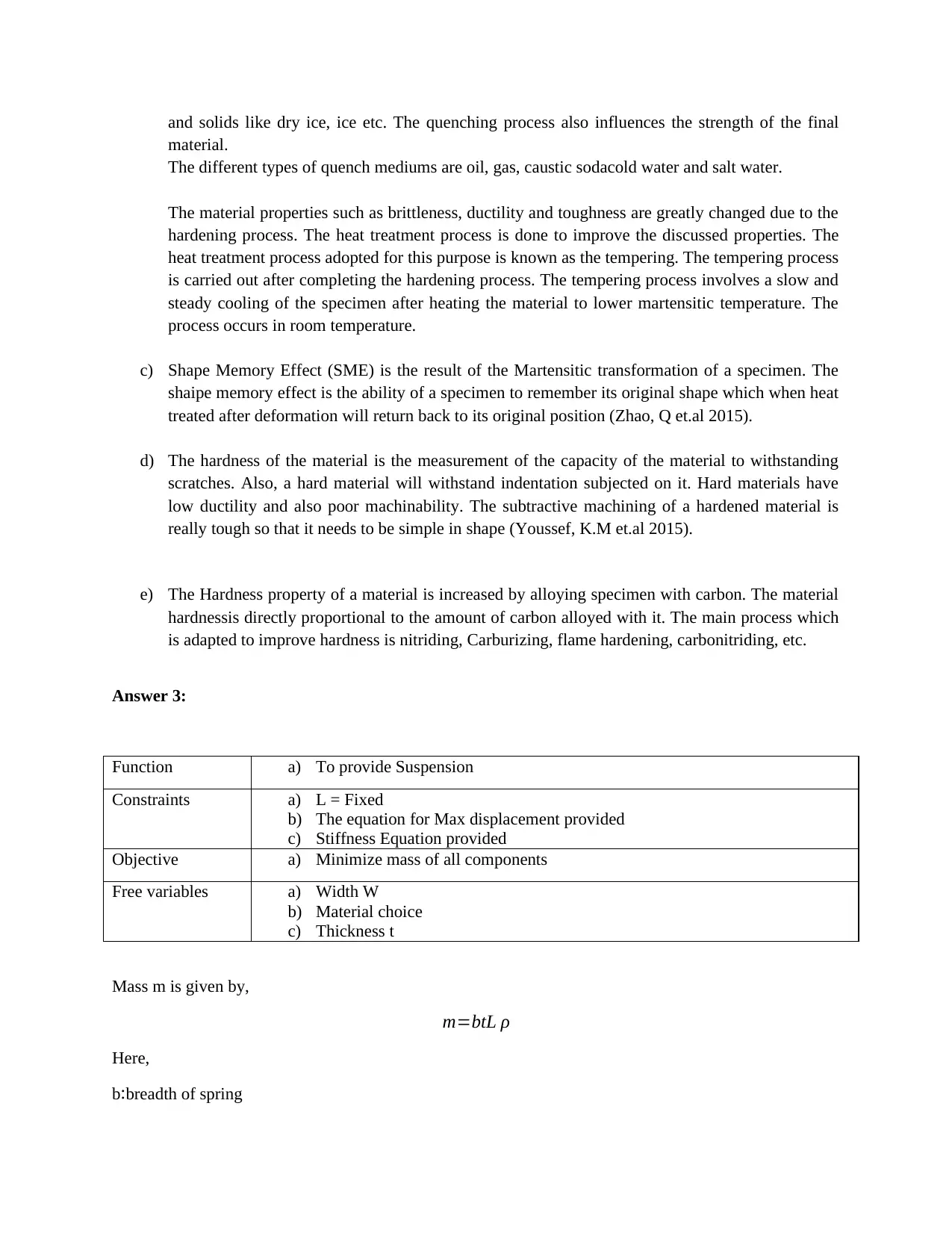
and solids like dry ice, ice etc. The quenching process also influences the strength of the final
material.
The different types of quench mediums are oil, gas, caustic sodacold water and salt water.
The material properties such as brittleness, ductility and toughness are greatly changed due to the
hardening process. The heat treatment process is done to improve the discussed properties. The
heat treatment process adopted for this purpose is known as the tempering. The tempering process
is carried out after completing the hardening process. The tempering process involves a slow and
steady cooling of the specimen after heating the material to lower martensitic temperature. The
process occurs in room temperature.
c) Shape Memory Effect (SME) is the result of the Martensitic transformation of a specimen. The
shaipe memory effect is the ability of a specimen to remember its original shape which when heat
treated after deformation will return back to its original position (Zhao, Q et.al 2015).
d) The hardness of the material is the measurement of the capacity of the material to withstanding
scratches. Also, a hard material will withstand indentation subjected on it. Hard materials have
low ductility and also poor machinability. The subtractive machining of a hardened material is
really tough so that it needs to be simple in shape (Youssef, K.M et.al 2015).
e) The Hardness property of a material is increased by alloying specimen with carbon. The material
hardnessis directly proportional to the amount of carbon alloyed with it. The main process which
is adapted to improve hardness is nitriding, Carburizing, flame hardening, carbonitriding, etc.
Answer 3:
Function a) To provide Suspension
Constraints a) L = Fixed
b) The equation for Max displacement provided
c) Stiffness Equation provided
Objective a) Minimize mass of all components
Free variables a) Width W
b) Material choice
c) Thickness t
Mass m is given by,
m=btL ρ
Here,
b:breadth of spring
material.
The different types of quench mediums are oil, gas, caustic sodacold water and salt water.
The material properties such as brittleness, ductility and toughness are greatly changed due to the
hardening process. The heat treatment process is done to improve the discussed properties. The
heat treatment process adopted for this purpose is known as the tempering. The tempering process
is carried out after completing the hardening process. The tempering process involves a slow and
steady cooling of the specimen after heating the material to lower martensitic temperature. The
process occurs in room temperature.
c) Shape Memory Effect (SME) is the result of the Martensitic transformation of a specimen. The
shaipe memory effect is the ability of a specimen to remember its original shape which when heat
treated after deformation will return back to its original position (Zhao, Q et.al 2015).
d) The hardness of the material is the measurement of the capacity of the material to withstanding
scratches. Also, a hard material will withstand indentation subjected on it. Hard materials have
low ductility and also poor machinability. The subtractive machining of a hardened material is
really tough so that it needs to be simple in shape (Youssef, K.M et.al 2015).
e) The Hardness property of a material is increased by alloying specimen with carbon. The material
hardnessis directly proportional to the amount of carbon alloyed with it. The main process which
is adapted to improve hardness is nitriding, Carburizing, flame hardening, carbonitriding, etc.
Answer 3:
Function a) To provide Suspension
Constraints a) L = Fixed
b) The equation for Max displacement provided
c) Stiffness Equation provided
Objective a) Minimize mass of all components
Free variables a) Width W
b) Material choice
c) Thickness t
Mass m is given by,
m=btL ρ
Here,
b:breadth of spring
⊘ This is a preview!⊘
Do you want full access?
Subscribe today to unlock all pages.

Trusted by 1+ million students worldwide
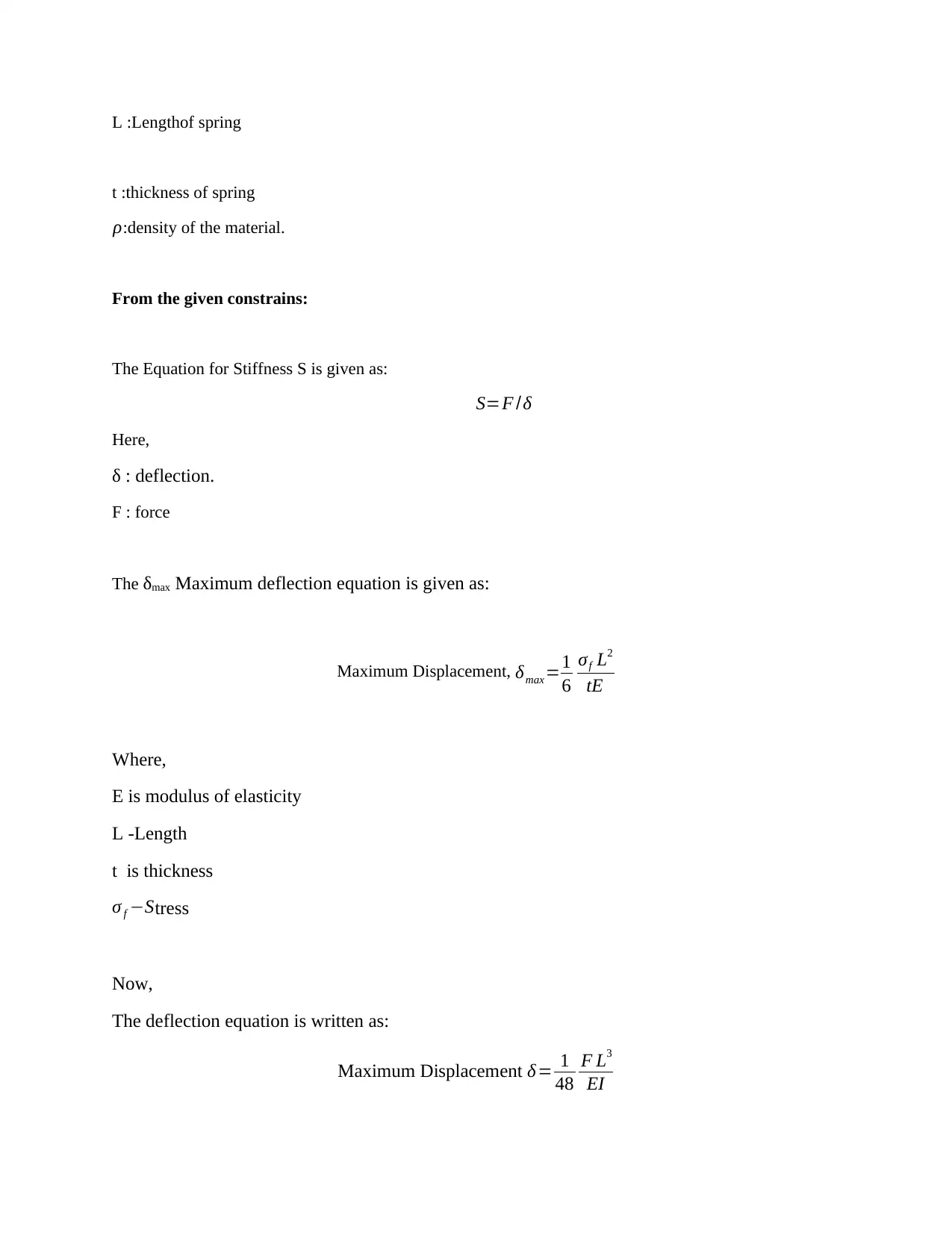
L :Lengthof spring
t :thickness of spring
ρ:density of the material.
From the given constrains:
The Equation for Stiffness S is given as:
S=F /δ
Here,
δ : deflection.
F : force
The δmax Maximum deflection equation is given as:
Maximum Displacement, δmax =1
6
σf L2
tE
Where,
E is modulus of elasticity
L -Length
t is thickness
σ f −Stress
Now,
The deflection equation is written as:
Maximum Displacement δ= 1
48
F L3
EI
t :thickness of spring
ρ:density of the material.
From the given constrains:
The Equation for Stiffness S is given as:
S=F /δ
Here,
δ : deflection.
F : force
The δmax Maximum deflection equation is given as:
Maximum Displacement, δmax =1
6
σf L2
tE
Where,
E is modulus of elasticity
L -Length
t is thickness
σ f −Stress
Now,
The deflection equation is written as:
Maximum Displacement δ= 1
48
F L3
EI
Paraphrase This Document
Need a fresh take? Get an instant paraphrase of this document with our AI Paraphraser
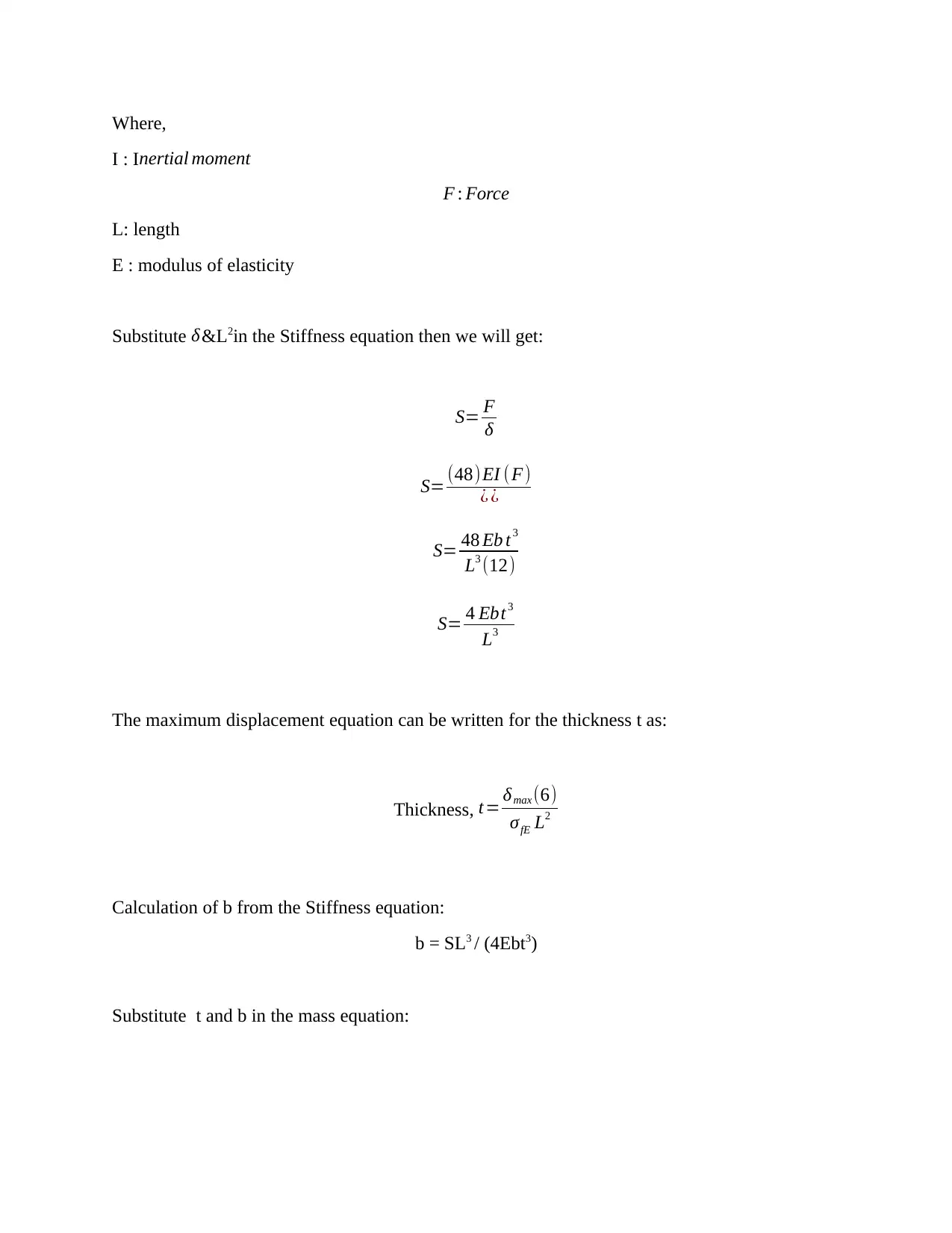
Where,
I : Inertial moment
F : Force
L: length
E : modulus of elasticity
Substitute δ&L2in the Stiffness equation then we will get:
S= F
δ
S= (48)EI (F)
¿ ¿
S= 48 Eb t 3
L3 (12)
S= 4 Ebt3
L3
The maximum displacement equation can be written for the thickness t as:
Thickness, t= δ max (6)
σfE L2
Calculation of b from the Stiffness equation:
b = SL3 / (4Ebt3)
Substitute t and b in the mass equation:
I : Inertial moment
F : Force
L: length
E : modulus of elasticity
Substitute δ&L2in the Stiffness equation then we will get:
S= F
δ
S= (48)EI (F)
¿ ¿
S= 48 Eb t 3
L3 (12)
S= 4 Ebt3
L3
The maximum displacement equation can be written for the thickness t as:
Thickness, t= δ max (6)
σfE L2
Calculation of b from the Stiffness equation:
b = SL3 / (4Ebt3)
Substitute t and b in the mass equation:
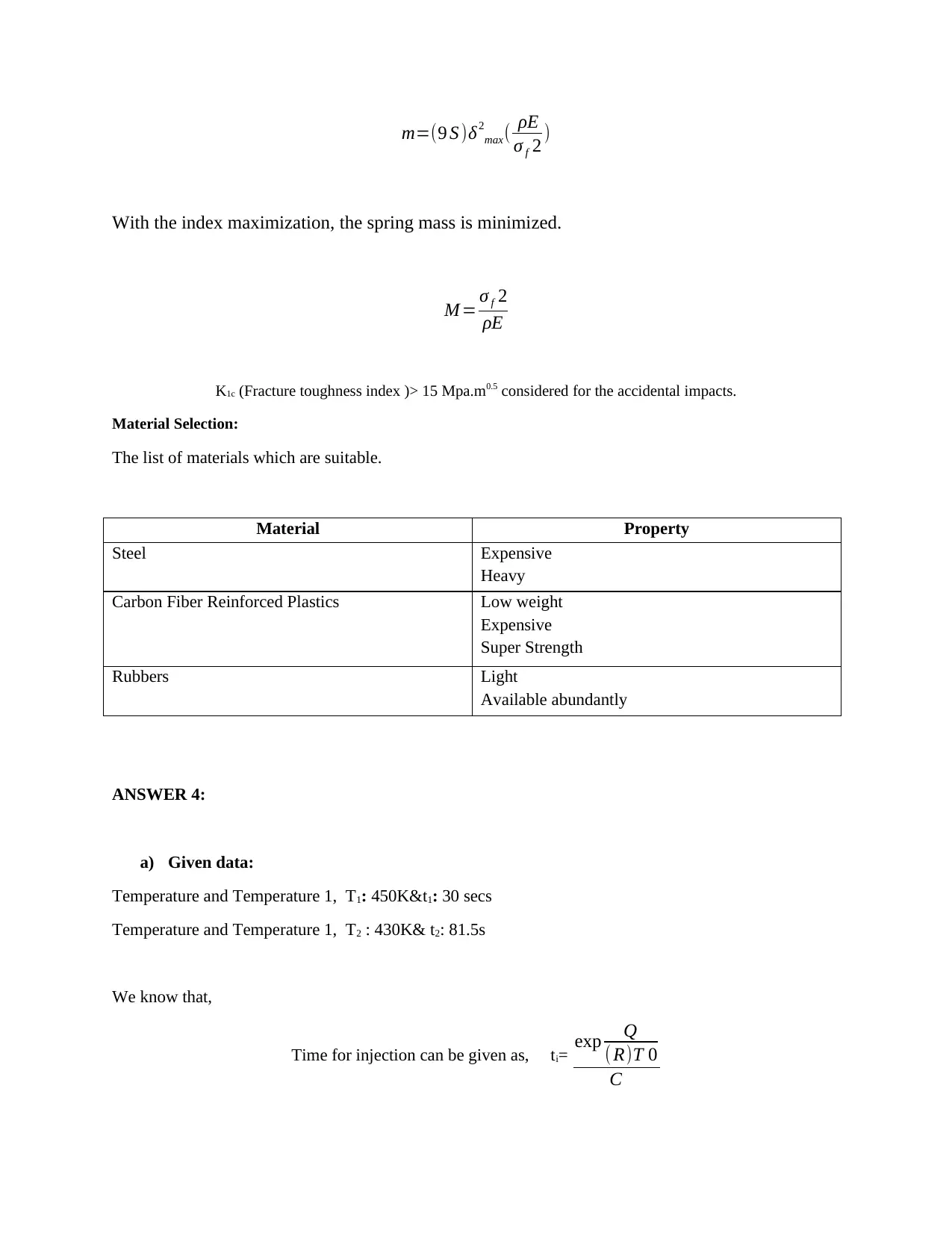
m=(9 S )δ2
max( ρE
σ f 2 )
With the index maximization, the spring mass is minimized.
M = σ f 2
ρE
K1c (Fracture toughness index )> 15 Mpa.m0.5 considered for the accidental impacts.
Material Selection:
The list of materials which are suitable.
Material Property
Steel Expensive
Heavy
Carbon Fiber Reinforced Plastics Low weight
Expensive
Super Strength
Rubbers Light
Available abundantly
ANSWER 4:
a) Given data:
Temperature and Temperature 1, T1: 450K&t1: 30 secs
Temperature and Temperature 1, T2 : 430K& t2: 81.5s
We know that,
Time for injection can be given as, ti= exp Q
( R)T 0
C
max( ρE
σ f 2 )
With the index maximization, the spring mass is minimized.
M = σ f 2
ρE
K1c (Fracture toughness index )> 15 Mpa.m0.5 considered for the accidental impacts.
Material Selection:
The list of materials which are suitable.
Material Property
Steel Expensive
Heavy
Carbon Fiber Reinforced Plastics Low weight
Expensive
Super Strength
Rubbers Light
Available abundantly
ANSWER 4:
a) Given data:
Temperature and Temperature 1, T1: 450K&t1: 30 secs
Temperature and Temperature 1, T2 : 430K& t2: 81.5s
We know that,
Time for injection can be given as, ti= exp Q
( R)T 0
C
⊘ This is a preview!⊘
Do you want full access?
Subscribe today to unlock all pages.

Trusted by 1+ million students worldwide
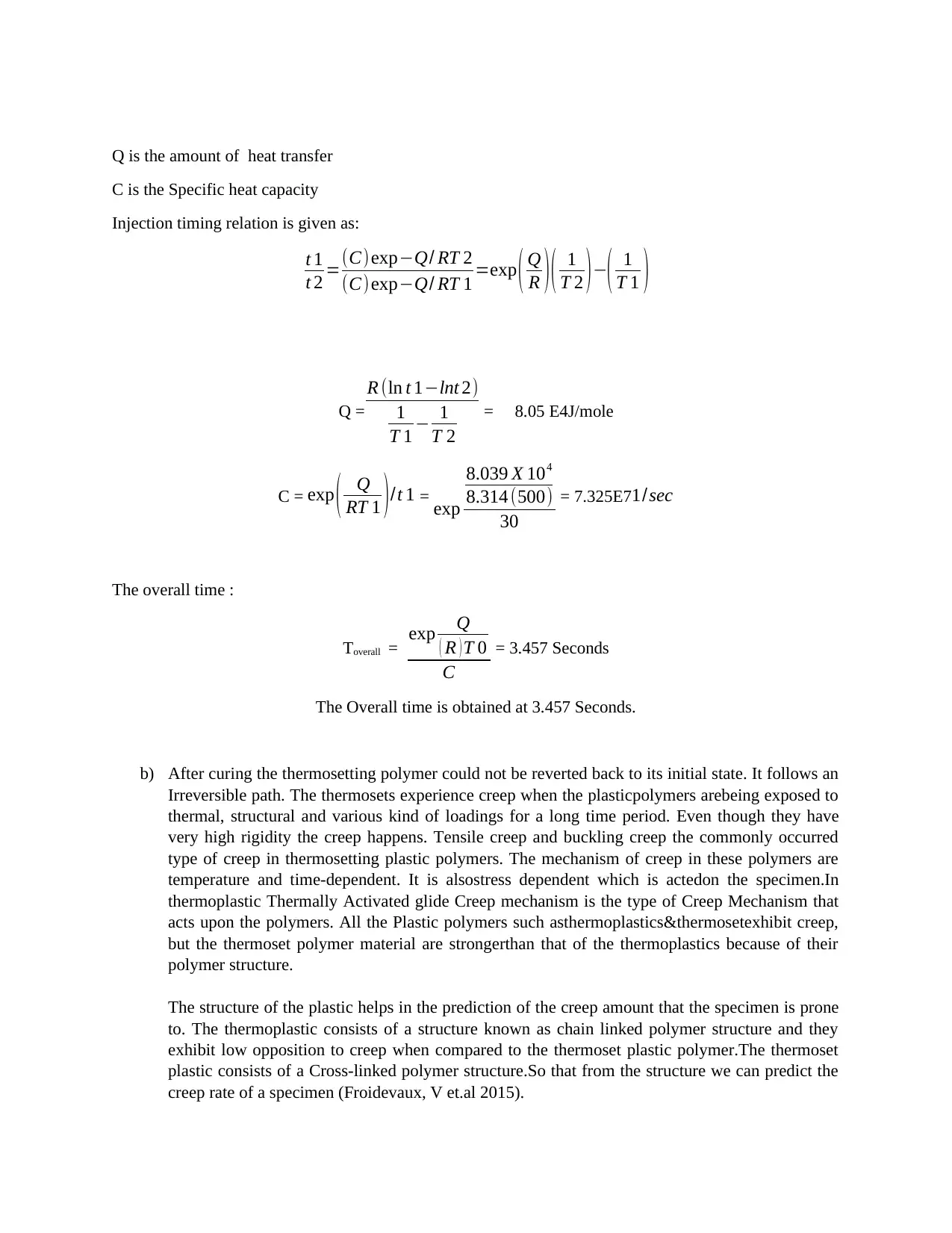
Q is the amount of heat transfer
C is the Specific heat capacity
Injection timing relation is given as:
t 1
t 2 =(C)exp−Q/ RT 2
(C)exp−Q/ RT 1 =exp ( Q
R )( 1
T 2 ) −( 1
T 1 )
Q =
R (ln t 1−lnt 2)
1
T 1 − 1
T 2
= 8.05 E4J/mole
C = exp ( Q
RT 1 )/t 1 = exp
8.039 X 104
8.314 (500)
30
= 7.325E71/sec
The overall time :
Toverall = exp Q
( R ) T 0
C
= 3.457 Seconds
The Overall time is obtained at 3.457 Seconds.
b) After curing the thermosetting polymer could not be reverted back to its initial state. It follows an
Irreversible path. The thermosets experience creep when the plasticpolymers arebeing exposed to
thermal, structural and various kind of loadings for a long time period. Even though they have
very high rigidity the creep happens. Tensile creep and buckling creep the commonly occurred
type of creep in thermosetting plastic polymers. The mechanism of creep in these polymers are
temperature and time-dependent. It is alsostress dependent which is actedon the specimen.In
thermoplastic Thermally Activated glide Creep mechanism is the type of Creep Mechanism that
acts upon the polymers. All the Plastic polymers such asthermoplastics&thermosetexhibit creep,
but the thermoset polymer material are strongerthan that of the thermoplastics because of their
polymer structure.
The structure of the plastic helps in the prediction of the creep amount that the specimen is prone
to. The thermoplastic consists of a structure known as chain linked polymer structure and they
exhibit low opposition to creep when compared to the thermoset plastic polymer.The thermoset
plastic consists of a Cross-linked polymer structure.So that from the structure we can predict the
creep rate of a specimen (Froidevaux, V et.al 2015).
C is the Specific heat capacity
Injection timing relation is given as:
t 1
t 2 =(C)exp−Q/ RT 2
(C)exp−Q/ RT 1 =exp ( Q
R )( 1
T 2 ) −( 1
T 1 )
Q =
R (ln t 1−lnt 2)
1
T 1 − 1
T 2
= 8.05 E4J/mole
C = exp ( Q
RT 1 )/t 1 = exp
8.039 X 104
8.314 (500)
30
= 7.325E71/sec
The overall time :
Toverall = exp Q
( R ) T 0
C
= 3.457 Seconds
The Overall time is obtained at 3.457 Seconds.
b) After curing the thermosetting polymer could not be reverted back to its initial state. It follows an
Irreversible path. The thermosets experience creep when the plasticpolymers arebeing exposed to
thermal, structural and various kind of loadings for a long time period. Even though they have
very high rigidity the creep happens. Tensile creep and buckling creep the commonly occurred
type of creep in thermosetting plastic polymers. The mechanism of creep in these polymers are
temperature and time-dependent. It is alsostress dependent which is actedon the specimen.In
thermoplastic Thermally Activated glide Creep mechanism is the type of Creep Mechanism that
acts upon the polymers. All the Plastic polymers such asthermoplastics&thermosetexhibit creep,
but the thermoset polymer material are strongerthan that of the thermoplastics because of their
polymer structure.
The structure of the plastic helps in the prediction of the creep amount that the specimen is prone
to. The thermoplastic consists of a structure known as chain linked polymer structure and they
exhibit low opposition to creep when compared to the thermoset plastic polymer.The thermoset
plastic consists of a Cross-linked polymer structure.So that from the structure we can predict the
creep rate of a specimen (Froidevaux, V et.al 2015).
Paraphrase This Document
Need a fresh take? Get an instant paraphrase of this document with our AI Paraphraser
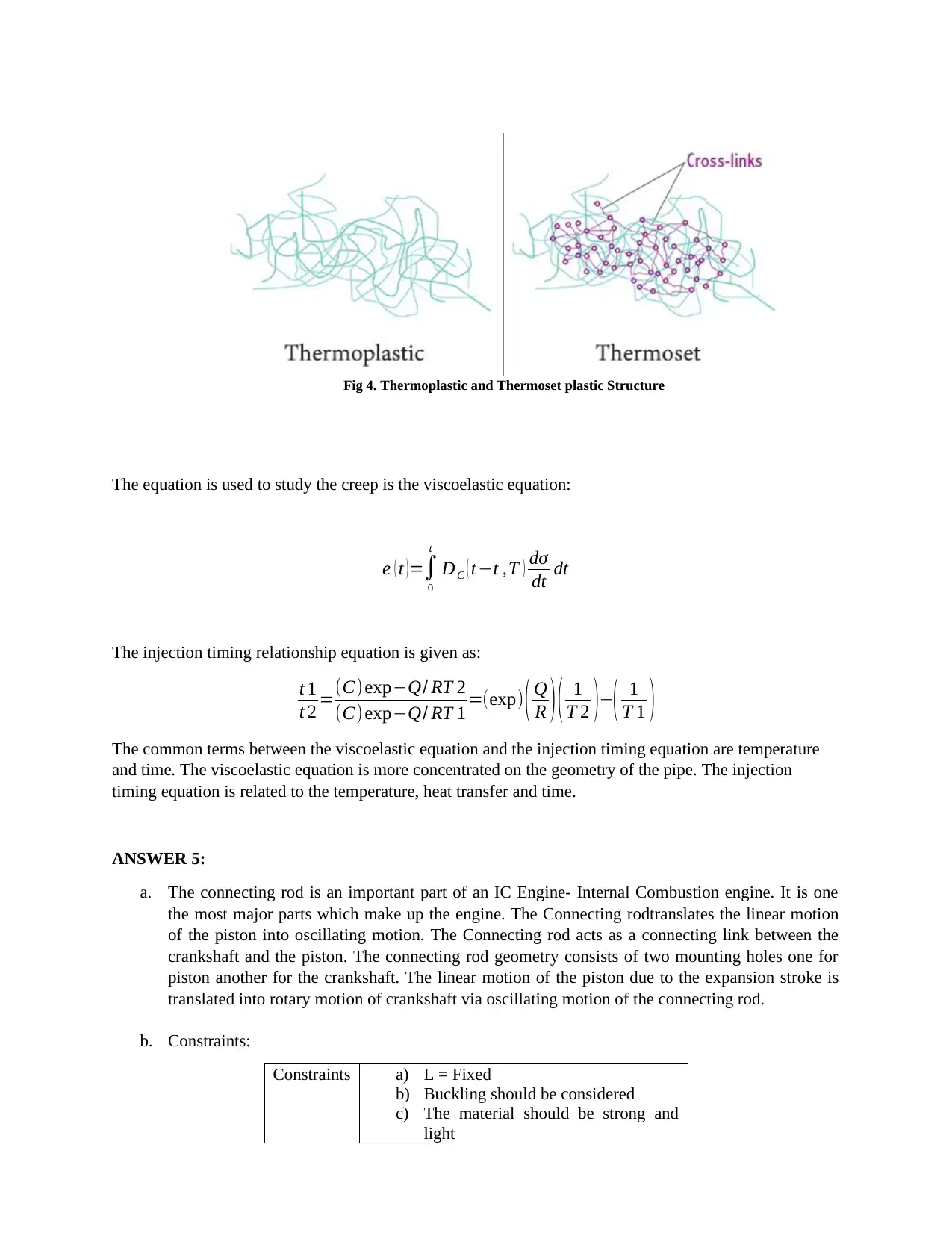
Fig 4. Thermoplastic and Thermoset plastic Structure
The equation is used to study the creep is the viscoelastic equation:
e ( t )=∫
0
t
DC ( t−t ,T ) dσ
dt dt
The injection timing relationship equation is given as:
t 1
t 2 =(C) exp−Q/ RT 2
(C) exp−Q/ RT 1 =(exp) ( Q
R )( 1
T 2 )−( 1
T 1 )
The common terms between the viscoelastic equation and the injection timing equation are temperature
and time. The viscoelastic equation is more concentrated on the geometry of the pipe. The injection
timing equation is related to the temperature, heat transfer and time.
ANSWER 5:
a. The connecting rod is an important part of an IC Engine- Internal Combustion engine. It is one
the most major parts which make up the engine. The Connecting rodtranslates the linear motion
of the piston into oscillating motion. The Connecting rod acts as a connecting link between the
crankshaft and the piston. The connecting rod geometry consists of two mounting holes one for
piston another for the crankshaft. The linear motion of the piston due to the expansion stroke is
translated into rotary motion of crankshaft via oscillating motion of the connecting rod.
b. Constraints:
Constraints a) L = Fixed
b) Buckling should be considered
c) The material should be strong and
light
The equation is used to study the creep is the viscoelastic equation:
e ( t )=∫
0
t
DC ( t−t ,T ) dσ
dt dt
The injection timing relationship equation is given as:
t 1
t 2 =(C) exp−Q/ RT 2
(C) exp−Q/ RT 1 =(exp) ( Q
R )( 1
T 2 )−( 1
T 1 )
The common terms between the viscoelastic equation and the injection timing equation are temperature
and time. The viscoelastic equation is more concentrated on the geometry of the pipe. The injection
timing equation is related to the temperature, heat transfer and time.
ANSWER 5:
a. The connecting rod is an important part of an IC Engine- Internal Combustion engine. It is one
the most major parts which make up the engine. The Connecting rodtranslates the linear motion
of the piston into oscillating motion. The Connecting rod acts as a connecting link between the
crankshaft and the piston. The connecting rod geometry consists of two mounting holes one for
piston another for the crankshaft. The linear motion of the piston due to the expansion stroke is
translated into rotary motion of crankshaft via oscillating motion of the connecting rod.
b. Constraints:
Constraints a) L = Fixed
b) Buckling should be considered
c) The material should be strong and
light

c. The objectives are to make a connecting rod which can Withstand the Force load of 20KN,
Lighter & stronger and resistive to fatigue & buckling.
d. The variable which is not bound to any constraints is known as the free variables. The free
variables provide us with the free will to choose them. Such as the material choice, width, length
and thickness, etc.
e. The mass equationfor the connecting rod:
Mass, m = (Ma)+ (Mb)+(Mc)
Ma Rectangle
Mb Circle 1
Mc Circle 2
m=¿] ρ in kilograms
Here,
ρ- Material density
Da& Db – Diameter of the upper and lower circles.
b – the breadth of the connecting rod
W- width of the connecting rod
t- the thickness of the connecting rod
f. The Fatigue material indices is a mathematical expression of fatigue load factor
governing the system it can be found at:
M = E/ρ
Ffatigue= π 2 EI
L2
E = FL2 / π2 I
M = FL2ρ / π2 I
g. The Connecting rod Mass is calculated in subdivision e as:
m=¿ ) ρ in kgs
Lighter & stronger and resistive to fatigue & buckling.
d. The variable which is not bound to any constraints is known as the free variables. The free
variables provide us with the free will to choose them. Such as the material choice, width, length
and thickness, etc.
e. The mass equationfor the connecting rod:
Mass, m = (Ma)+ (Mb)+(Mc)
Ma Rectangle
Mb Circle 1
Mc Circle 2
m=¿] ρ in kilograms
Here,
ρ- Material density
Da& Db – Diameter of the upper and lower circles.
b – the breadth of the connecting rod
W- width of the connecting rod
t- the thickness of the connecting rod
f. The Fatigue material indices is a mathematical expression of fatigue load factor
governing the system it can be found at:
M = E/ρ
Ffatigue= π 2 EI
L2
E = FL2 / π2 I
M = FL2ρ / π2 I
g. The Connecting rod Mass is calculated in subdivision e as:
m=¿ ) ρ in kgs
⊘ This is a preview!⊘
Do you want full access?
Subscribe today to unlock all pages.

Trusted by 1+ million students worldwide
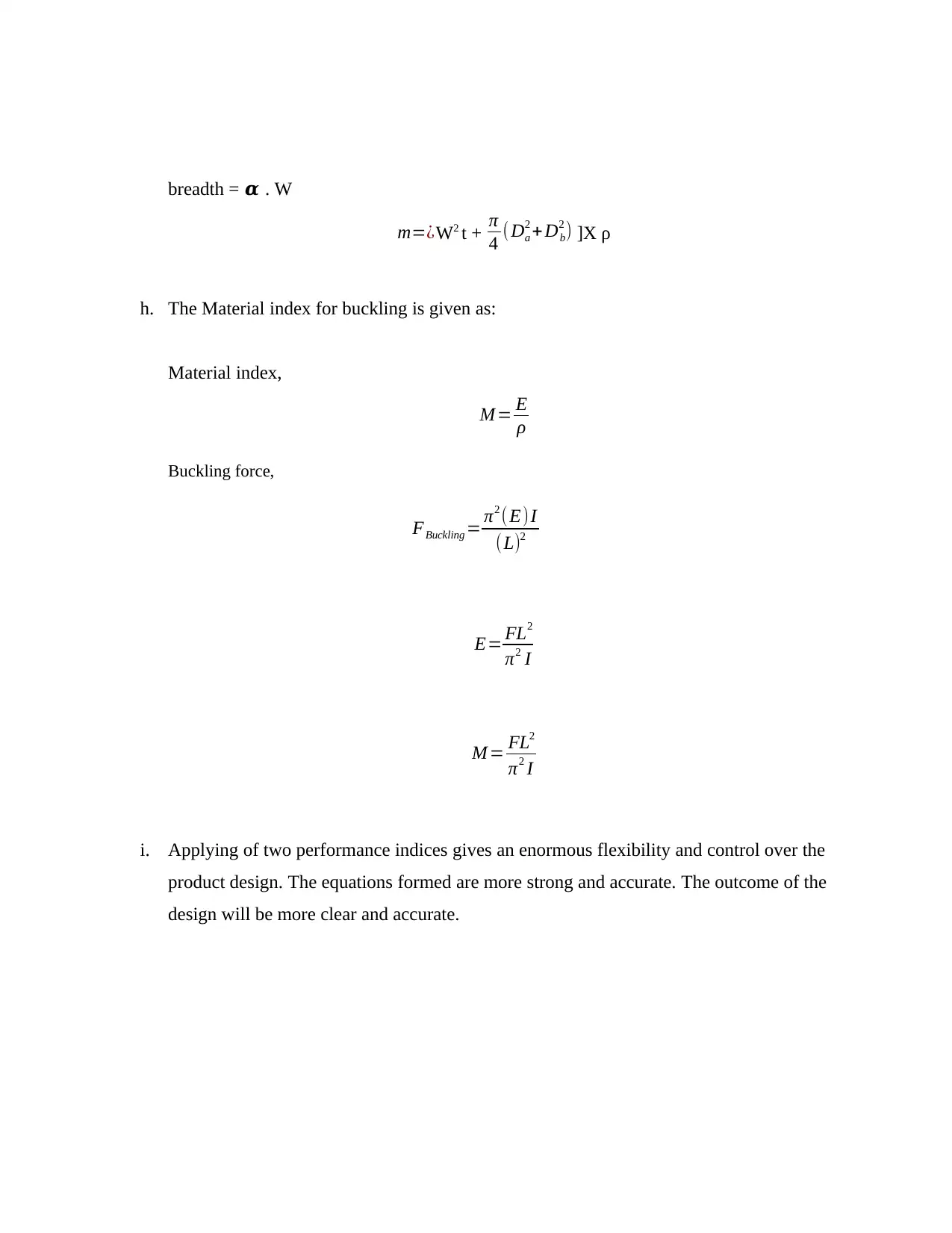
breadth = 𝜶 . W
m=¿W2 t + π
4 ( Da
2 + Db
2 ) ]X ρ
h. The Material index for buckling is given as:
Material index,
M = E
ρ
Buckling force,
FBuckling = π2 ( E)I
(L)2
E= FL2
π2 I
M = FL2
π2 I
i. Applying of two performance indices gives an enormous flexibility and control over the
product design. The equations formed are more strong and accurate. The outcome of the
design will be more clear and accurate.
m=¿W2 t + π
4 ( Da
2 + Db
2 ) ]X ρ
h. The Material index for buckling is given as:
Material index,
M = E
ρ
Buckling force,
FBuckling = π2 ( E)I
(L)2
E= FL2
π2 I
M = FL2
π2 I
i. Applying of two performance indices gives an enormous flexibility and control over the
product design. The equations formed are more strong and accurate. The outcome of the
design will be more clear and accurate.
Paraphrase This Document
Need a fresh take? Get an instant paraphrase of this document with our AI Paraphraser
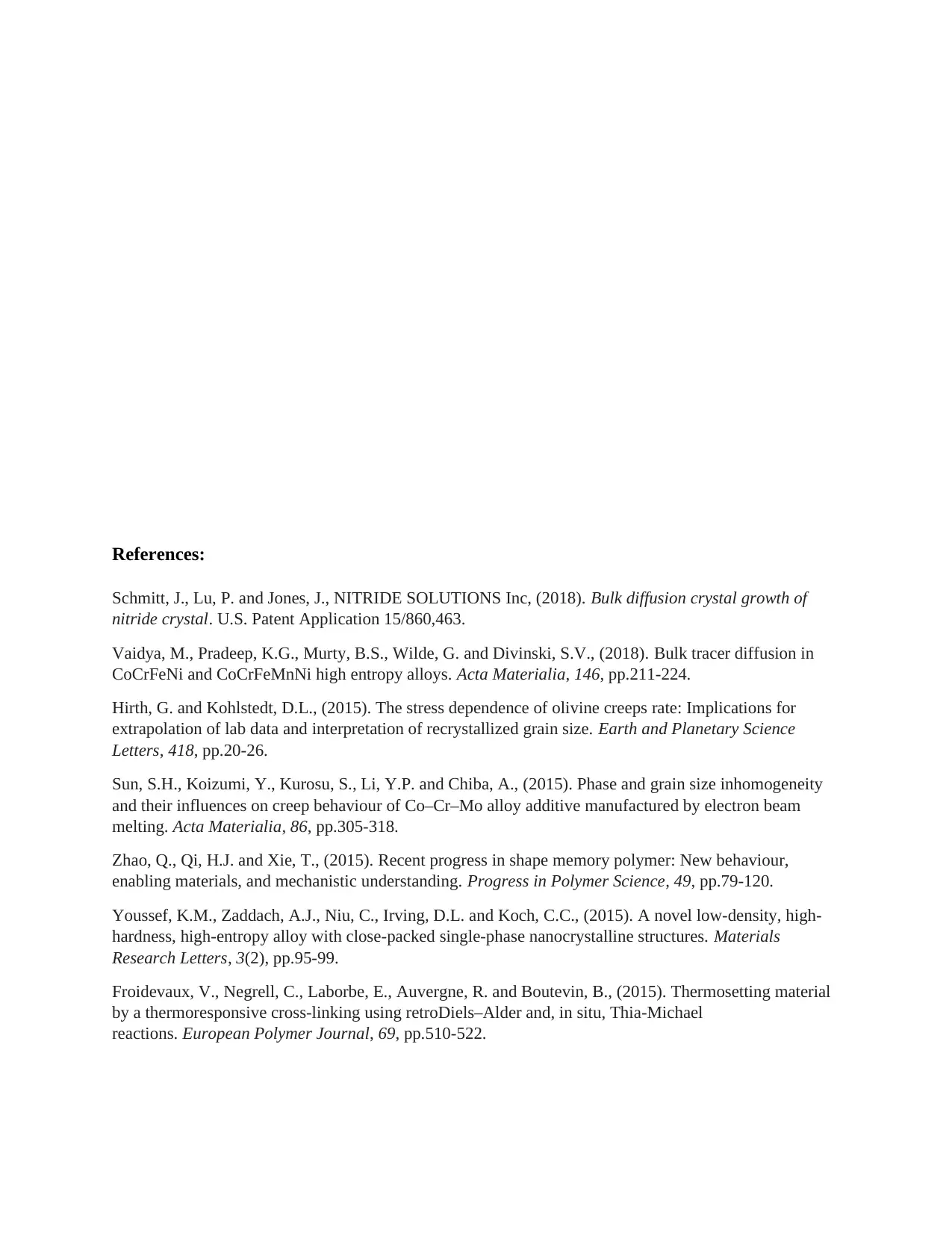
References:
Schmitt, J., Lu, P. and Jones, J., NITRIDE SOLUTIONS Inc, (2018). Bulk diffusion crystal growth of
nitride crystal. U.S. Patent Application 15/860,463.
Vaidya, M., Pradeep, K.G., Murty, B.S., Wilde, G. and Divinski, S.V., (2018). Bulk tracer diffusion in
CoCrFeNi and CoCrFeMnNi high entropy alloys. Acta Materialia, 146, pp.211-224.
Hirth, G. and Kohlstedt, D.L., (2015). The stress dependence of olivine creeps rate: Implications for
extrapolation of lab data and interpretation of recrystallized grain size. Earth and Planetary Science
Letters, 418, pp.20-26.
Sun, S.H., Koizumi, Y., Kurosu, S., Li, Y.P. and Chiba, A., (2015). Phase and grain size inhomogeneity
and their influences on creep behaviour of Co–Cr–Mo alloy additive manufactured by electron beam
melting. Acta Materialia, 86, pp.305-318.
Zhao, Q., Qi, H.J. and Xie, T., (2015). Recent progress in shape memory polymer: New behaviour,
enabling materials, and mechanistic understanding. Progress in Polymer Science, 49, pp.79-120.
Youssef, K.M., Zaddach, A.J., Niu, C., Irving, D.L. and Koch, C.C., (2015). A novel low-density, high-
hardness, high-entropy alloy with close-packed single-phase nanocrystalline structures. Materials
Research Letters, 3(2), pp.95-99.
Froidevaux, V., Negrell, C., Laborbe, E., Auvergne, R. and Boutevin, B., (2015). Thermosetting material
by a thermoresponsive cross-linking using retroDiels–Alder and, in situ, Thia-Michael
reactions. European Polymer Journal, 69, pp.510-522.
Schmitt, J., Lu, P. and Jones, J., NITRIDE SOLUTIONS Inc, (2018). Bulk diffusion crystal growth of
nitride crystal. U.S. Patent Application 15/860,463.
Vaidya, M., Pradeep, K.G., Murty, B.S., Wilde, G. and Divinski, S.V., (2018). Bulk tracer diffusion in
CoCrFeNi and CoCrFeMnNi high entropy alloys. Acta Materialia, 146, pp.211-224.
Hirth, G. and Kohlstedt, D.L., (2015). The stress dependence of olivine creeps rate: Implications for
extrapolation of lab data and interpretation of recrystallized grain size. Earth and Planetary Science
Letters, 418, pp.20-26.
Sun, S.H., Koizumi, Y., Kurosu, S., Li, Y.P. and Chiba, A., (2015). Phase and grain size inhomogeneity
and their influences on creep behaviour of Co–Cr–Mo alloy additive manufactured by electron beam
melting. Acta Materialia, 86, pp.305-318.
Zhao, Q., Qi, H.J. and Xie, T., (2015). Recent progress in shape memory polymer: New behaviour,
enabling materials, and mechanistic understanding. Progress in Polymer Science, 49, pp.79-120.
Youssef, K.M., Zaddach, A.J., Niu, C., Irving, D.L. and Koch, C.C., (2015). A novel low-density, high-
hardness, high-entropy alloy with close-packed single-phase nanocrystalline structures. Materials
Research Letters, 3(2), pp.95-99.
Froidevaux, V., Negrell, C., Laborbe, E., Auvergne, R. and Boutevin, B., (2015). Thermosetting material
by a thermoresponsive cross-linking using retroDiels–Alder and, in situ, Thia-Michael
reactions. European Polymer Journal, 69, pp.510-522.
1 out of 11
Related Documents
Your All-in-One AI-Powered Toolkit for Academic Success.
+13062052269
info@desklib.com
Available 24*7 on WhatsApp / Email
![[object Object]](/_next/static/media/star-bottom.7253800d.svg)
Unlock your academic potential
Copyright © 2020–2025 A2Z Services. All Rights Reserved. Developed and managed by ZUCOL.



